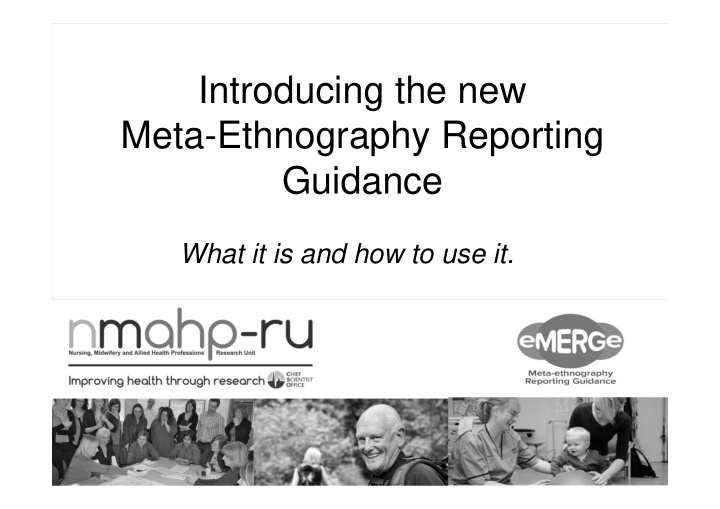



Introducing the new Meta-Ethnography Reporting Guidance What it is and how to use it.
Project team: Emma France, 1 Nicola Ring, 2 Maggie Cunningham 1 , Isabelle Uny 1 , Edward Duncan, 1 Rachel Roberts, 1 Ruth Jepson, 3 Margaret Maxwell, 1 Ruth Turley, 4 Jane Noyes. 5 1 University of Stirling, 2 Edinburgh Napier University 3 SCPHRP, University of Edinburgh, 4 University of Cardiff, 5 Bangor University. Project funded by NIHR Health Service & Delivery Research Grant 13/114/60 (2015-17)
What is meta-ethnography? Meta-ethnography (ME) developed by George Noblit & Dwight Hare in USA, in field of education. Noblit & Hare (1988). Meta-ethnography: synthesizing qualitative studies. Beverly Hills: SAGE Publications. ME – bringing together standalone qualitative research studies to provide a new interpretation. ‘Making a whole into something more than the parts alone imply’ (1988:28). George W. Noblit
The 7 phases of a meta-ethnography Phase 1: Getting started Phase 2: Deciding what is relevant to the initial interest Phase 3: Reading the studies Phase 4: Determining how the studies are related Phase 5: Translating the studies into one another Phase 6: Synthesising translations Phase 7: Expressing the synthesis
Why is ME reporting guidance needed? ME increasingly used in health research but reporting is highly variable in quality. This means: • Some ‘ME’ reports are so poor its not clear whether what is reported is actually ME. • ME reports lack transparency so its difficult to assess their quality and credibility. • Readers lack confidence in some ME findings • This reduces the potential utility of ME to inform health care practice, policy & research.
Guidance development process Stages Outputs Stage 1. Review of guidance on Provisional audit ME conduct & reporting standards for ME conduct & reporting Stage 2. Review & audit of published meta-ethnographies against provisional standards Preliminary ME reporting items Stage 3. ‘Test’ preliminary reporting items (Delphi) Preliminary ME reporting criteria Stage 4. Refine & agree reporting criteria. Disseminate.
Who is the ME reporting guidance for? Possible Researchers users of the eMERGE Patient & Guideline ME Lay Groups developers reporting guidance eMERGE Users e.g. e.g. PhD Health students & technology supervisors assessors Journal editors & reviewers
eMERGe reporting guidance consists of three Parts: • Part 1: Guidance Table containing summary of reporting criteria • Part 2: Explanatory notes • Part 3: Extensions to the reporting criteria.
Part 1: Guidance Table: • 1 page summary of reporting criteria only • 19 reporting criteria – common to all ME • Criteria structured to: • Reflect the 7 ME phases • Link to journal paper section headings
Reporting Examples No. Criteria Reporting Criteria Heading Phase 1 – Selecting meta-ethnography and getting started Introduction 1 Rationale and Describe the research or knowledge gap to be filled by the meta-ethnography, and the context for the wider context of the meta-ethnography. meta- ethnography 2 Aim(s) of the Describe the meta-ethnography aim(s). meta- ethnography
Reporting Examples Phase 5 – Translating studies into one another Methods 13 Process of Describe the methods of translation: translating - Describe steps taken to preserve the context and meaning of the relationships between studies concepts within and across studies. - Describe how the reciprocal and refutational translations were conducted. - Describe how potential alternative interpretations or explanations were considered in the translation. Findings 14 Outcome of Describe the interpretive findings of the translation. translation
Part 2: Explanatory notes (EN) provide details of how to apply the criteria. Phase 5, criterion 13: EN suggest e.g. - What type of narrative could be provided to indicate how context were preserved. - What visual aids could indicate how relationships between concepts were preserved. - Possible ways to report refutational translations.
Reporting Examples Phase 7 – Expressing the synthesis Discussion 18 Strengths, Reflect on and describe the full context and limitations of the synthesis: limitations & - Internal context e.g. describe how the reflexivity nature of the included studies, and how the meta-ethnography was conducted influenced the synthesis findings. - External context e.g. compare the output of the synthesis in the context of existing literature. 19 Recommend- Describe the implications of the synthesis. ations and conclusions
Part 3: Extensions to the reporting criteria: 1. Format of the ME output (report) 2. Assessment of the methodological strengths and limitations of included studies 3. Using GRADE-CERQual to assess confidence in findings from qualitative evidence syntheses.
Supporting materials Journal papers: France et al. Improving reporting of Meta-Ethnography: The eMERGe Reporting Guidance (in development). Expected publication later 2017. Related publications to follow reporting different eMERGE stages. Training materials: • 4 short films by George Noblit, Emma France, Jane Noyes & Nicola Ring – due summer 2017 • Webinar recording Available at: www.emergeproject.org
Your questions?
With grateful thanks to: The NIHR for funding the project Professor George Noblit Project Advisory Group: members & chair (Sheena Blair) Steve Boulton for online support Lonnie Wright & Lynne Gilmour for filming All other Collaborators & Supporters – too many to name individually but we wish to thank them all as we could not have done this work without them. The eMERGe team!
References: France E, Ring N, Thomas R, Noyes J, Maxwell M, Jepson R. A methodological systematic review of what’s wrong with meta-ethnography reporting. BMC Medical Research Methodology (2014) doi: 10.1186/1471- 2288-14-119. France E, Ring N, Noyes J, Maxwell M, Jepson R, Duncan E, Turley R, Jones D, Uny I. Protocol-developing meta-ethnography reporting guidelines (eMERGe). BMC Medical Research Methodology (2015) 15:103 DOI 10.1186/s12874-015-0068-0. France E, et al. Improving reporting of meta-ethnography: The eMERGE reporting guidance. (2017) ( In development) Noblit G. Hare D. (1988) Meta-ethnography: synthesising qualitative studies. Beverley Hills: SAGE publications
Recommend
More recommend